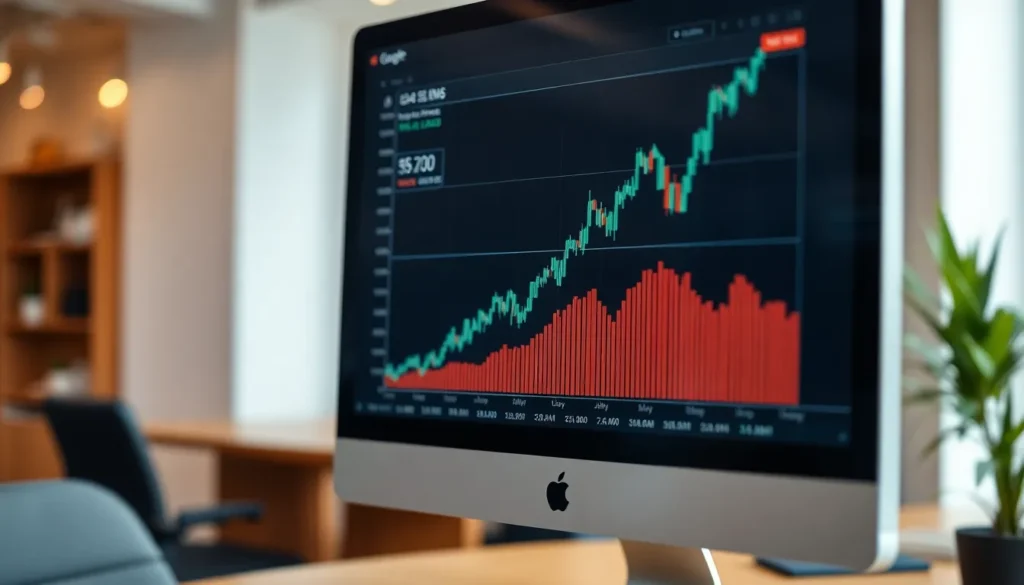Table of Contents
ToggleWhen it comes to navigating the unpredictable waters of the stock market, investors often seek reliable tools to guide their decisions. Enter the Google 200-day moving average—your trusty compass in a sea of volatility. This powerful indicator smooths out price fluctuations, allowing investors to spot trends without getting dizzy from the daily ups and downs.
Understanding Google 200 Day Moving Average
The Google 200-day moving average serves as a key metric for investors observing market trends. This average offers insights into stock performance over a significant period.
What Is a Moving Average?
A moving average calculates the average price of a security over a specific time frame. This average adjusts as new data comes in, providing a dynamic view of price trends. The 200-day moving average specifically considers the last 200 days of pricing data. Investors use this measure to gauge the long-term trend of an asset. It filters out daily price volatility, allowing for a clearer perspective on price movements.
Importance of Moving Averages in Trading
Moving averages hold substantial relevance in trading strategies. They help investors identify potential buy and sell signals. A common method involves observing price crossovers with the moving average. When an asset’s price surpasses its moving average, it often indicates an upward trend. Conversely, when the price falls below the moving average, it may signal a downward trend. Traders rely on this information to inform their decisions, making moving averages a fundamental tool for market analysis.
Analyzing Google’s 200 Day Moving Average

Understanding Google’s 200-day moving average provides valuable insights into its stock performance and market trends. This indicator plays a critical role in smoothing out day-to-day price fluctuations, essential for long-term investors.
Historical Trends and Data
Historical trends demonstrate the strength of Google’s 200-day moving average in identifying significant price movements. For instance, from 2010 to 2020, the stock often rebounded when approaching this moving average, indicating strong underlying support. During bearish markets, such as in 2022, the pattern often correlated with declining stock prices, showcasing its reliability in market corrections. Analyzing past data reveals a consistent pattern; breakouts above the average frequently aligned with bullish sentiment. Investors often rely on this historical analysis to predict future movements, substantiating its importance in a trader’s toolkit.
Current Performance and Significance
Current performance highlights the continuing relevance of Google’s 200-day moving average. As of October 2023, Google’s stock remains above this moving average, signaling positive momentum. Immediate fluctuations in the market usually remain manageable due to this average acting as a reference point for stability. Investors observe this position carefully, as staying above it tends to reflect bullish conditions. Conversely, tests below this level may prompt reevaluation of market strategies. Moving averages remain indispensable for both short-term traders and long-term investors, emphasizing their role in strategic decision-making.
How to Use Google 200 Day Moving Average in Trading Strategies
The Google 200-day moving average provides critical insights for traders. Utilizing it effectively can enhance decision-making in both entry and exit strategies.
Entry and Exit Points
Traders consider the Google 200-day moving average when determining entry and exit points. When stock prices cross above the moving average, it often signals a potential entry opportunity. Observing this crossover can confirm bullish momentum, encouraging investors to buy. Conversely, if prices fall below the moving average, an exit may be prudent. This indicates a possible decline, prompting a reassessment of holdings. Analyzing historical patterns provides additional validation, as Google’s price movements frequently reflect these signals. Such strategic planning ensures traders can capitalize on market opportunities.
Risk Management Techniques
Incorporating risk management techniques is vital for traders using the Google 200-day moving average. One effective approach involves setting stop-loss orders when entering trades. Placing stop-loss orders slightly below the moving average can limit potential losses. Considering position sizing also helps mitigate risk. Allocating a certain percentage of the total capital per trade ensures exposure remains manageable. Additionally, traders should monitor the moving average for shifts. Adjusting the stop-loss as the moving average rises enables continuous protection. This proactive strategy safeguards profits while maintaining a clear focus on market trends.
Tools for Tracking Google 200 Day Moving Average
Investors use various tools to track the Google 200-day moving average effectively. These resources provide real-time data, analysis, and visualization to enhance decision-making.
Recommended Platforms and Software
Traders often rely on platforms like TradingView, Thinkorswim, and MetaTrader for tracking moving averages. These platforms offer user-friendly interfaces and advanced charting tools. Features such as customizable indicators help users adapt the analysis to their trading strategies. Yahoo Finance provides an accessible option for monitoring stock performance and moving averages. Moreover, Google Finance allows users to view historical data easily, supporting long-term trend analysis. Each platform brings unique capabilities, catering to different trading styles.
Integrating Moving Averages into Your Trading Routine
Integrating moving averages into a trading routine enhances market analysis effectiveness. Traders frequently use daily charts to monitor the 200-day moving average, ensuring they spot trends without distraction. Positioning alerts around this moving average keeps traders informed about critical price movements. Additionally, combining moving averages with other technical indicators, such as RSI or MACD, enhances signal accuracy. Risk management techniques, including setting stop-loss orders, play a vital role in safeguarding investments. Regularly reviewing moving averages helps adjust strategies in response to changing market conditions.
The Google 200-day moving average stands out as a vital tool for investors aiming to navigate market volatility. Its ability to filter out daily price fluctuations provides clarity on long-term trends. By monitoring this moving average, traders can make informed decisions about entry and exit points while managing risks effectively.
As Google’s stock remains above this average, it signals positive momentum that investors should watch closely. Incorporating this indicator into trading strategies not only enhances market analysis but also supports sound decision-making. Overall, the Google 200-day moving average is essential for both short-term traders and long-term investors looking to optimize their investment strategies.





